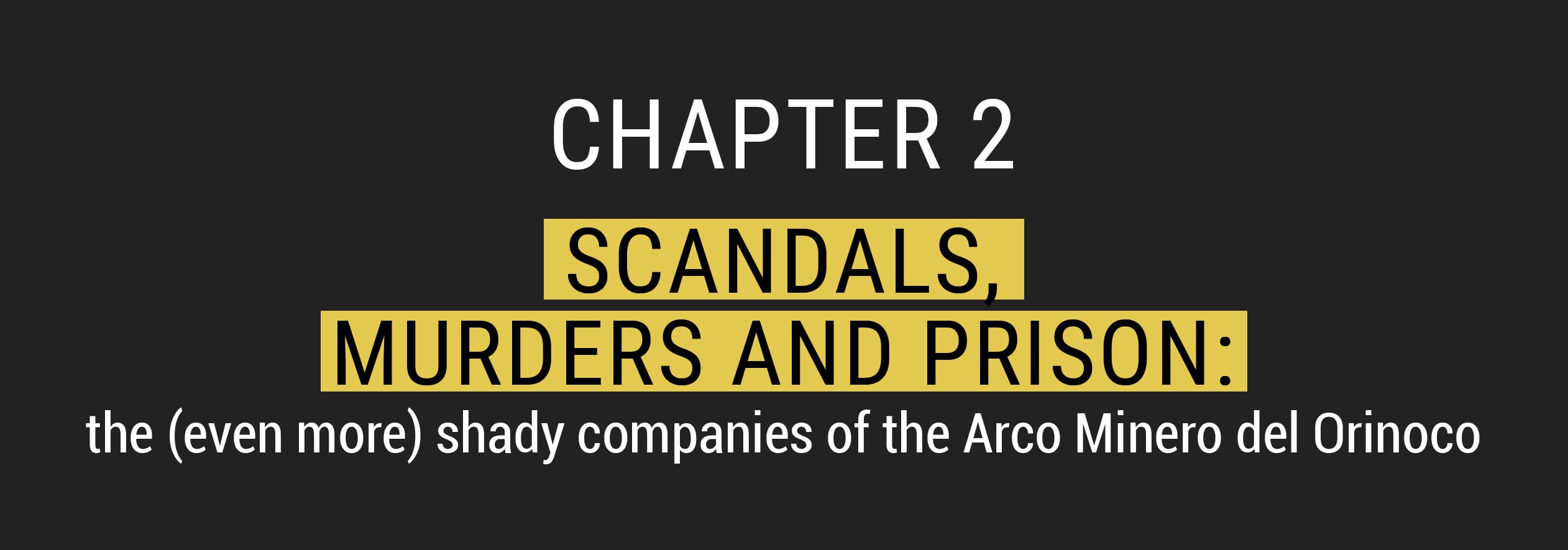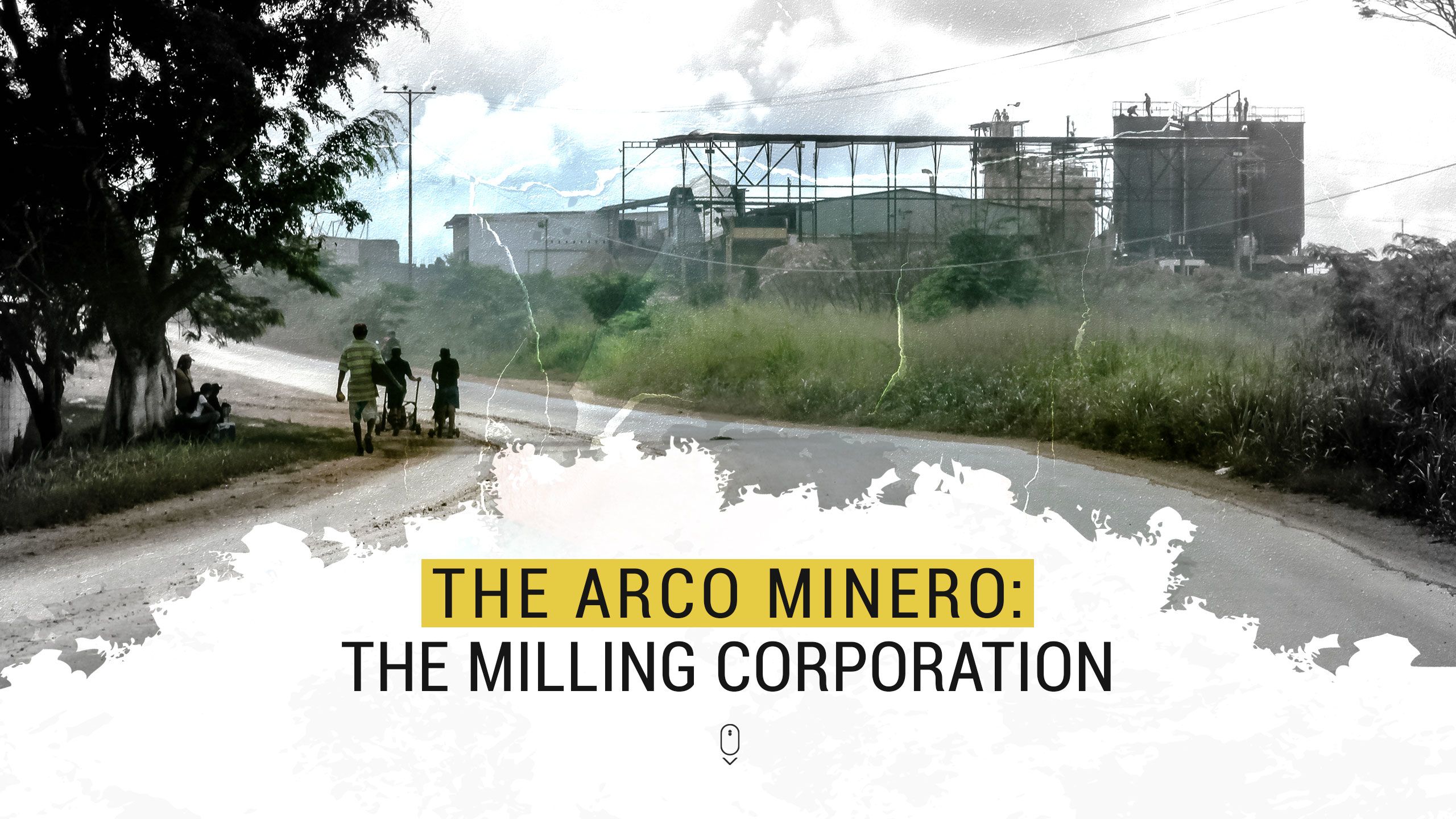
The notable emergence of cyanidation gold processing plants, strategic alliances and mills within the mining megaproject in the Bolívar state is inversely proportional to its transparency and legality. In a tour of Troncal 10, the Runrunes and Correo del Caroní team identified at least 41 companies of which the official contracting process and their performance in the auriferous production are not known. One sixth of these firms have been involved in corruption: their shareholders were accused of administrative irregularities in both national and international courts.
To one side of the Troncal 10, less than a kilometer from El Callao, a peculiar building rises on a small hill guarded by uniformed personnel. Its methodically painted blue walls as well as the gate crowned with the logo of a double A stand out in the changing landscape of the Arco Minero del Orinoco. Behind the hill, there is a reddish terrain and a few meters beyond a set of silos characteristic of cyanidation plants to extract gold.
Although there are no names in sight, it is Aurumin, a company that nobody knows where it came from or who it belongs to but has buses clearly labeled to transport its employees from the town center. It does not appear on the list of joint ventures or strategic alliances authorized by the Ministry of Eco-Mining Development (Ministerio de Desarrollo Minero Ecológico - Mindeminec) for gold mining in the south of Bolívar state. Nor does it show any poster as its neighbor GuayanaOro does, a plant formed as a strategic alliance between the Venezuelan Mining Corporation (Corporación Venezolana de Minería - CVM) and the private company Corporación GuayanaOro C.A., involved in stories of corruption and hired killers.
In contrast to its remarkable visibility on the main road artery of the Arco Minero, the tax data of the mysterious company remain hidden. It does not have phone numbers, website or contact emails. Aurumin is one of the many companies that rose up during the COVID-19 pandemic and that would be part of the mining megaproject decreed by Nicolás Maduro in 2016 with the intention of ordering and formalizing the exploitation of the so-called strategic materials (gold, diamond, coltan, and bauxite, among others) within almost 112 thousand square kilometers in the south of the country to turn it into an alternative source of resources to the ruined oil industry in Venezuela.

Aurumin's notoriety on Troncal 10 contradicts its opacity. Nobody knows if it is a mixed company, strategic alliance, or private company or its function in the Mining Arc.
Aurumin's notoriety on Troncal 10 contradicts its opacity. Nobody knows if it is a mixed company, strategic alliance, or private company or its function in the Mining Arc.
Aurumin well represents the set of public and private companies within the Arco Minero that are distinguished by secrecy. The blue-painted plant does not have a Tax Information Registry (Registro de Información Fiscal - RIF) and no one knows for sure if it is a strategic alliance, a state company, a joint venture, or a private firm.
Its name coincides with that of a similar company that exists in Australia, also dedicated to the mining sector and with no apparent relationship with Venezuela. Like the rest of the companies, it is unknown how and when it was registered or if it followed the formal public procurement processes, which by law must be adhered to by the parts of the state project that contributes to sustaining the government of Nicolás Maduro.
Through a tour of Runrun.es and Correo del Caroní across the Arco Minero del Orinoco in the first quarter of 2022, 41 companies installed along some 420 kilometers were identified, from Ciudad Guayana to Kilómetro 88, the border point of the Gran Sabana which is part of the Canaima National Park.
Of the total that make up the corporate map of the mining megaproject, 19 correspond to strategic alliances of auriferous sands (six of them are part of the Domingo Sifontes Industrial Complex in El Callao, the largest in the mining belt), two are joint ventures (55% state capital; 45% private), eight offer services and construction work, four provide supplies, and three are dedicated to specialized transportation for this sector. All would go through the registration and supervision of the almost omnipresent state-owned Venezuelan Mining Corporation (CVM), attached to the Ministry of Ecological Mining Development and chaired by General Carlos Osorio, a formality that does not necessarily translate into organization and planning.
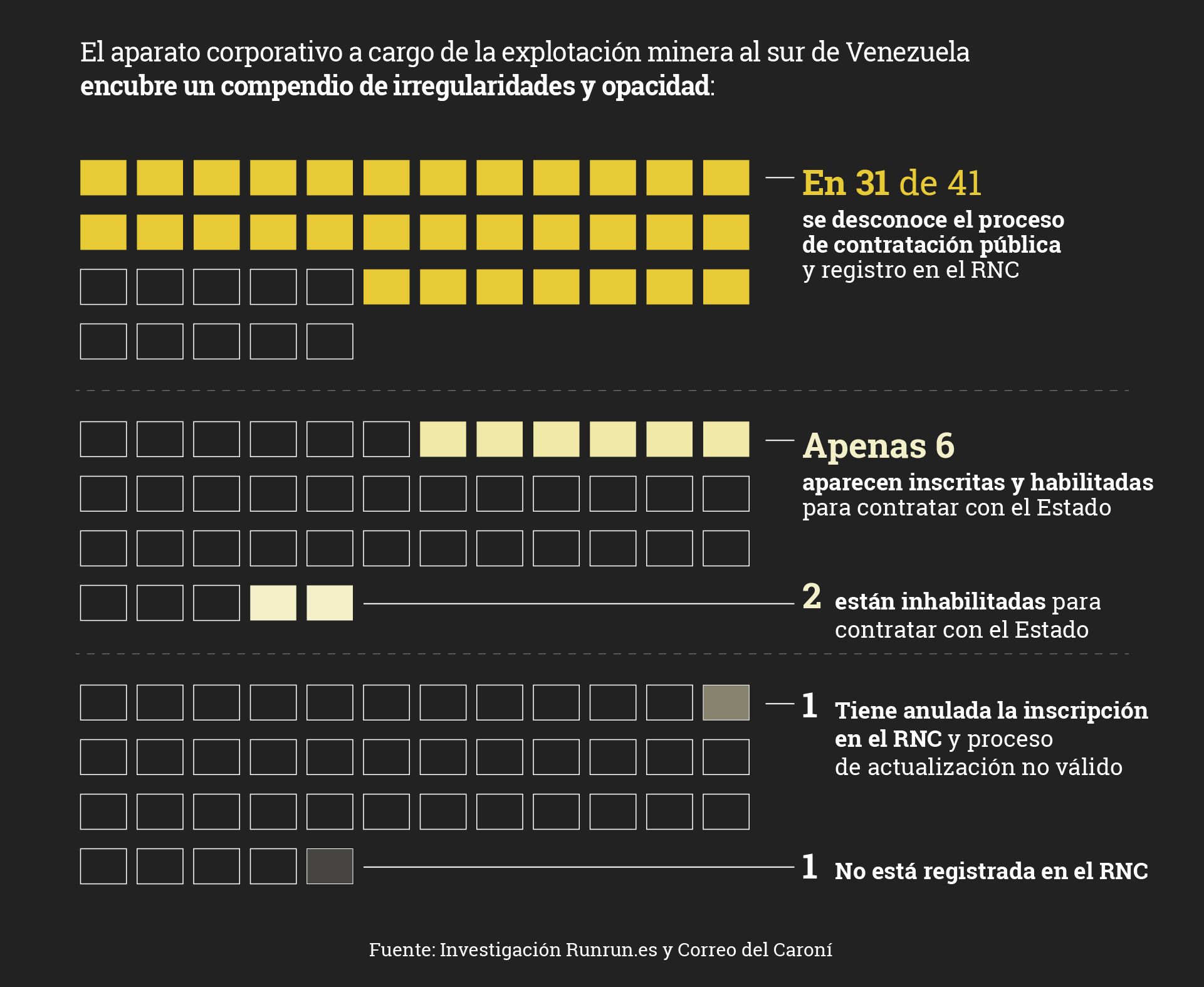
One sixth of the companies present in the Arco Minero del Orinoco have been involved in corruption: their shareholders were singled out for administrative irregularities in both national and international courts.
At least 14 of these strategic alliances identified in the Arco Minero were created between 2016 and 2017 when the mining megaproject was starting to kick off. Five years later, there are no guarantees which and how many are 100% active.
The original project of the Arco Minero proposed the creation of about twenty joint ventures for mining exploitation, in which the State would have a stake of at least 55% of the share capital, in accordance with Decree No. 2,165 that reserves to the Republic the activities of exploration and exploitation of gold and other strategic minerals. Under this figure, Mibiturven came to settle in El Callao, Berakah and Sarrapia in the Piar municipality, and Siembra Minera in Las Claritas. The headquarters of the latter located on one of the main streets of the village seems powered off. It is used today to celebrate religious events, as the team of reporters verified in January and September 2022.

The headquarters of the eco-socialist mixed company Siembra Minera S.A, in Las Claritas, is used for religious celebrations
The headquarters of the eco-socialist mixed company Siembra Minera S.A, in Las Claritas, is used for religious celebrations
“My son has been working for a while at one of the plants. The truth is that I don't even remember what it's called,” says a primary school teacher who lives in El Dorado, a town founded at the end of the XIX century that delimits kilometer zero of Troncal 10. In the Arco Minero it is not known the number of jobs generated by the companies installed in the last five years nor can it be measured if they have indeed brought the benefits to their workers, far from the objective that "small miners stop being slaves to become workers of the homeland" as was established by Mindeminec's mining management policy.
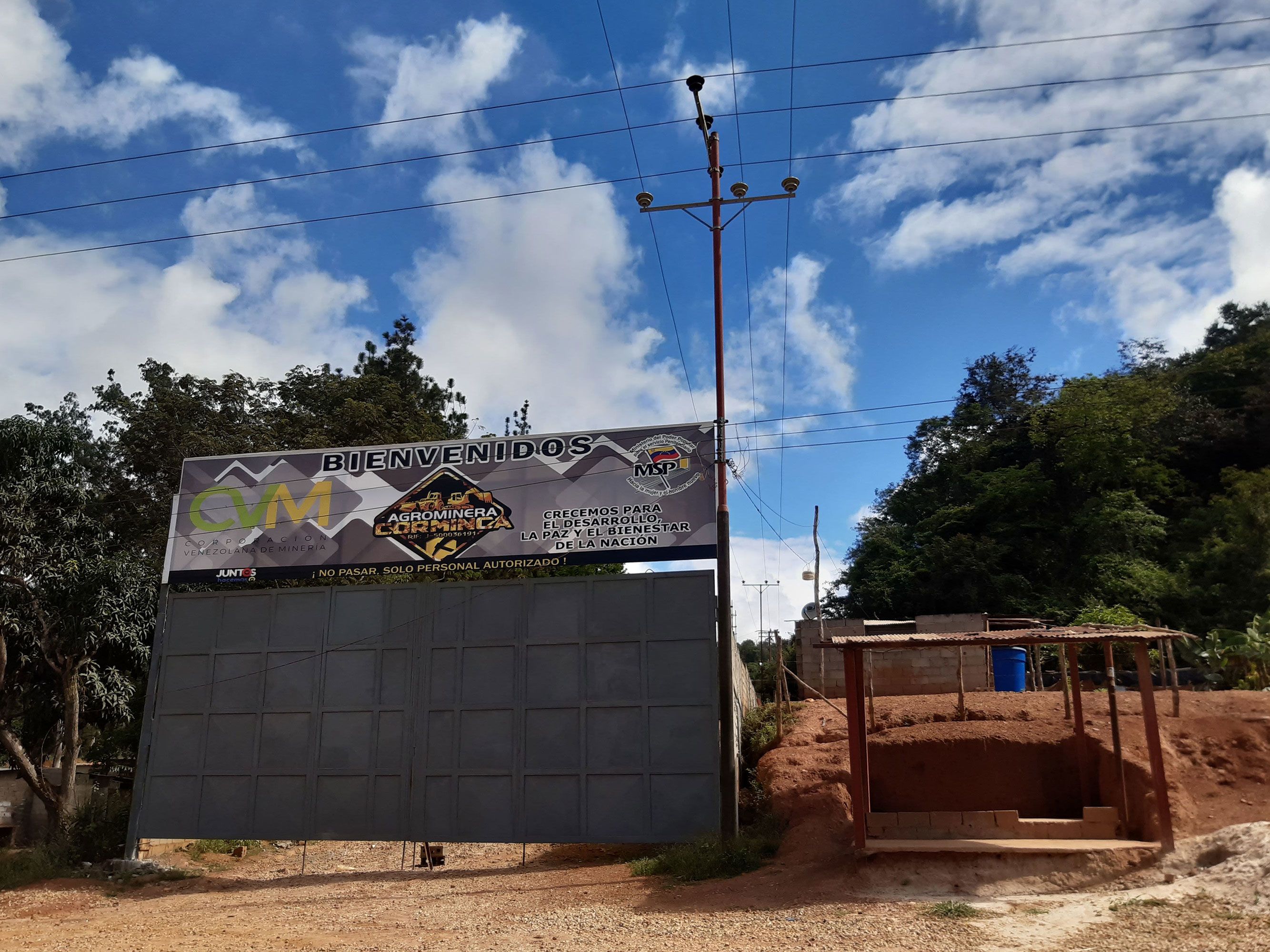
The sign of the Corminca Agrominera, located in El Callao, was removed in September 2022. It is attached to the Ministry of Penitentiary Affairs
The sign of the Corminca Agrominera, located in El Callao, was removed in September 2022. It is attached to the Ministry of Penitentiary Affairs
A devastated landscape
The irruption of gold recovery companies and plants during the COVID-19 pandemic disrupted the original habitat where the Arco Minero del Orinoco was delimited to the south of Bolívar state. The ravages of comes and goes of the transport of Brazilian goods, and the trucks loaded with tons of auriferous sands are evident in the deteriorated Troncal 10 that connects Venezuela with Brazil, mainly in the section that crosses the Roscio, El Callao, and Sifontes municipalities.
The change in the landscape in the municipalities crossed by Troncal 10 also shows a variation in the dynamics of approval of strategic alliances and production units in recent years, although it was not possible to confirm what type of agreement applies to these new companies.
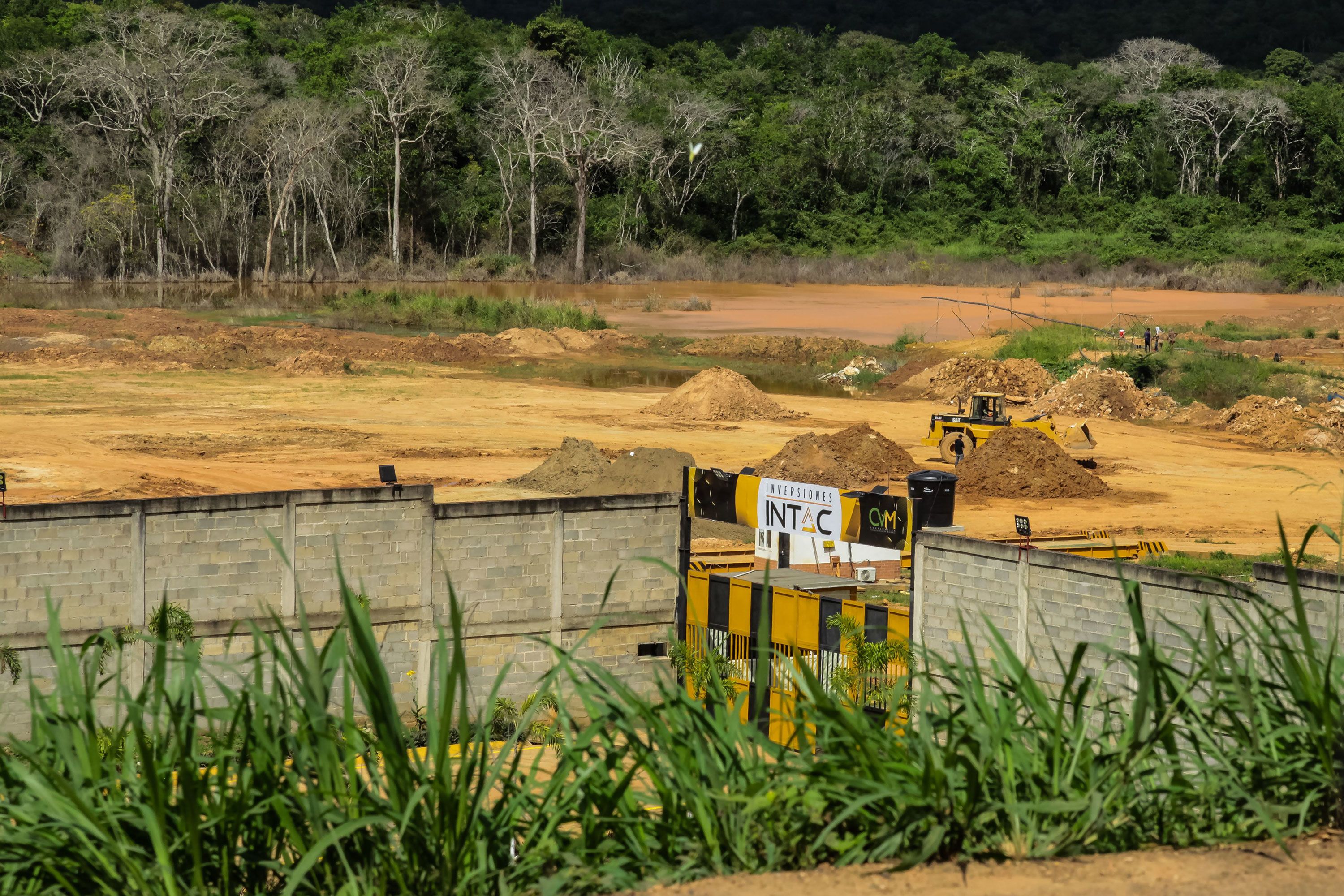
A landscape is repeated along the road: installation of industrial plants and mills, scrambled terrain, and felled forests
A landscape is repeated along the road: installation of industrial plants and mills, scrambled terrain, and felled forests
Only in the middle of Troncal 10, between Guasipati and the entrance to the town of El Callao, were observed at least 10 new mining works whose first structures indicate that it is the construction of mills and gold recovery plants.
Six of the developments are identified on their main facades: Goldtex, JC Eminca, Santa Bárbara, Planta Rita, La Increíble, and Corminca, the latter with logos of the Ministerio del Poder Popular para el Servicio Penitenciario (Ministry of Popular Power for the Penitentiary Service) that had already been withdrawn by September 2022. A few kilometers from the entrance to El Callao, on the road to Tumeremo in the Sifontes municipality, there are three other plants identified as Aurumin, Intac, and Guayana Oro.
Six years after the creation of the Arco Minero del Orinoco, it is not known with certainty how many plants and strategic alliances have been installed in the mining polygonal. The figures vary depending on the official announcements that have been issued throughout the years of gold exploitation under the government of Nicolás Maduro. Added to this inaccuracy is the fact that the directory of companies that associate with the State, through strategic alliances for the management of auriferous sands (leaching plants) as well as mill owners, remains opaque.
In 2016, the year of the launch of the Arco Minero, the Vice Minister of Monitoring and Control of Eco-Mining Development, Luis Salinas, stated that 42 strategic alliances had been established corresponding to small and medium-sized mining. Three of them with gold processing plants: La Vanguardia C.A., La Lucha 2016 C.A. and El Guayare C.A. Three years later, the Maduro government announced that 60 gold recovery plants would be installed in the south of Bolívar, but in September 2020, the Vice President of the Republic, Delcy Rodríguez, met with representatives of 21 active plants (in order to "review productivity") in addition to directors of seven plants that aspired to be activated by the end of that year, according to the official notice. However, Mindeminec keeps mentioning only eight strategic alliances for the gold sector in its mining projects bank.
The repository does not detail the status of the Plan Minero Tricolor (Tricolor Mining Plan) announced by Maduro on October 15, 2019, through which the concession of a mine is granted to each state government as a source of financing. Adolfo Pereira, current governor of Lara, caused a turmoil in social media in early 2022 by posting a video in which he appears visiting a rudimentary vertical system, popularly known as “barranco” (a shaft mine), in a Bolívar state mine that would have been assigned to him by Maduro. He did not indicate exactly what mine he was in, although he did show the precarious conditions in which artisanal miners work.

A signboard adjacent to the Complejo Domingo Sifontes Industrial in El Callao marks the location of the company Almaz Group of the Venezuela Palestine Agreement
A signboard adjacent to the Complejo Domingo Sifontes Industrial in El Callao marks the location of the company Almaz Group of the Venezuela Palestine Agreement
The announcement of Vice President Delcy Rodríguez in 2020 was the last official reference regarding the number of gold processing plants. Until before the arrival of the coronavirus in Venezuela, factories destined for gold extraction like recovery plants through cyanidation processes used to be built in internal areas of mining municipalities, away from Troncal 10, which a passer-by could not easily reach.
Not any more. As the COVID-19 pandemic progressed, mining began to show itself on the road to the municipalities of Sifontes and Gran Sabana. They are in sight of locals as well as astonished tourists who go in search of the natural beauties of the nearby Canaima National Park, and the hurried migrants who aspire to cross the border with Brazil.
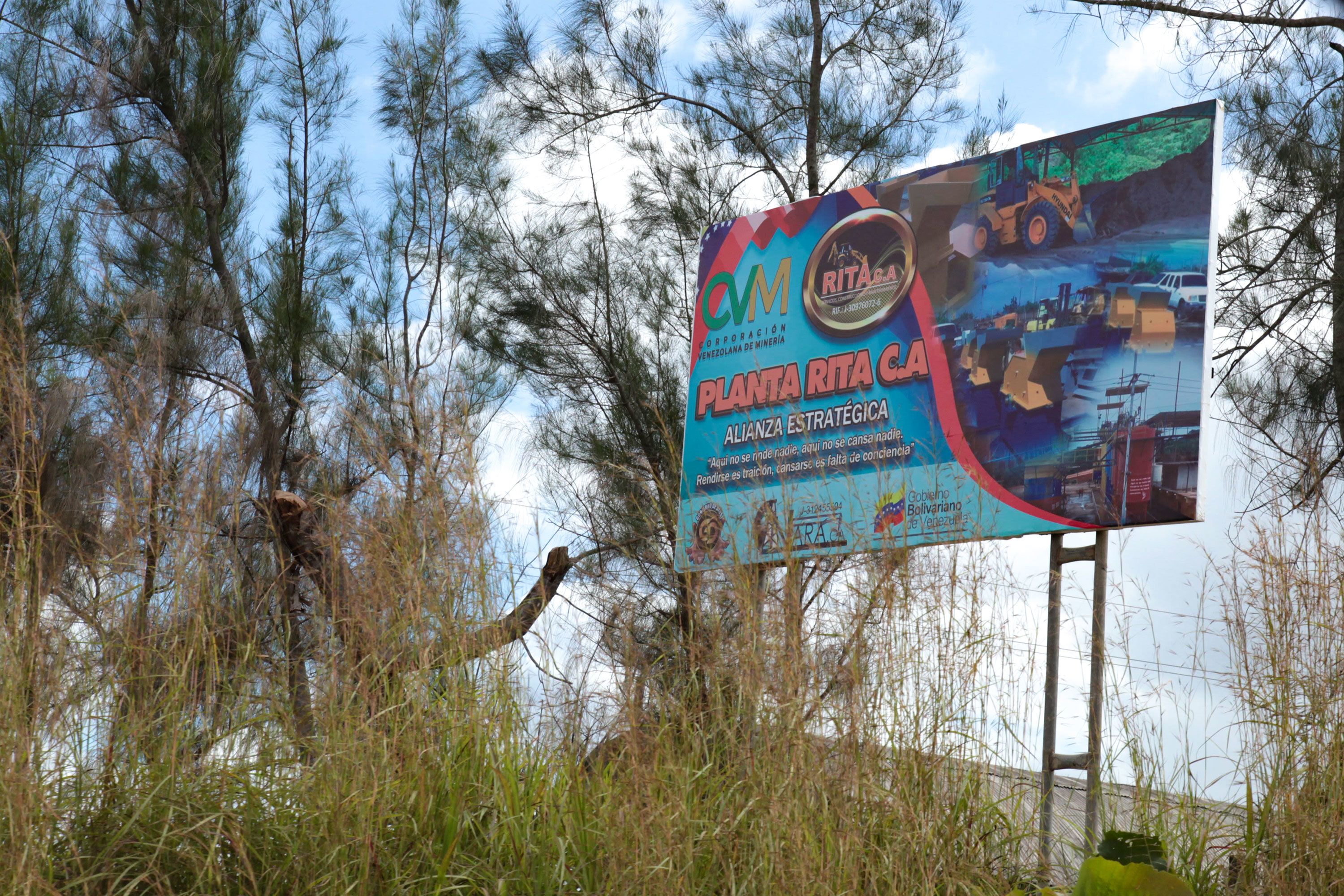
To the difficulty of counting how many strategic alliances for the recovery of gold sands by cyanidation are actually operating in the Arco Minero, is added the inaccuracy of the total strategic alliances of the State with small mining. According to the report "Achievements of the mining sector" of the Mindeminec, the CVM signed 768 alliances with mining organizations in the Arco Minero del Orinoco in 2018, of which 731 would be dedicated to the exploitation of gold and 37 to diamond.
These groups are nothing more than cooperatives that the small miners were forced to create in order to continue exploiting gold within the mining polygonal. Only with this record of the Mindeminec they have authorization to operate, a legal way to ensure the capture of the extracted gold. Four years later, the updated number of alliances signed with artisanal miners, the performance of these alliances and whether they are indeed working together with the State are completely unknown.
Alliances with small mining, by "Achievements of the mining sector in 2018", (Mindeminec, 2019).
Alliances with small mining, by "Achievements of the mining sector in 2018", (Mindeminec, 2019).
Further south, between the town of El Dorado and Tumeremo in the Sifontes municipality, the reportering team counted a dozen gold mills. The total number of installed mills corresponding to small-scale mining is also not known. In the municipality of El Callao alone, according to the authorities, there are 1,200 traditional mills operating.
Also in each municipality, sales premises for mining supplies were installed during the pandemic. The establishments, identified with the CVM logos, are operated by private companies: Corporación Nara (Las Claritas, Sifontes), Corporación Estrellas del Oro (El Callao) and LT Import (Upata, Piar).

Far from the promises of achieving regional welfare, labor unrest behind the facade of some strategic alliances has managed to transcend despite the secrecy of the State.
One of those labor nuisances exploded on September 4 at Troncal 10, near the La Camorra mine in El Dorado. Workers of the Consejos Comunales Agromineros (Agrominers Communal Councils) decided to block the international road in protest against the joint venture Binational Mining Turkey-Venezuela (Minería Binacional Turquía-Venezuela - Mibiturven) and the military repression of the Directorate of Military Counterintelligence (Dgcim). The guarantee of social investment in the communities stood out among the demands of the miners.
Also this year, artisanal miners from the El Limón sector of El Palmar, Padre Pedro Chien municipality, insistently denounced the mysterious company Sambuca 3000 C.A., especially its representative Yesel Calzadilla, for the diversion of 170,000 tons of auriferous sands without their corresponding payment to the workers. They warn that Mariannys Campos, spokeswoman for the CVM, and the mayor Benin David Ramos want to "impose Sambuca as operator of the sands of the Padre Pablo Chien municipality."
On June 9, 2022, seven miners from El Palmar denounced that Yesel Calzadilla and Nelly Sol Matute took 350 trucks of sand to be processed at the Manuel Carlos Piar Complex, in Puerto Ordaz, and only paid $600, that is, $1.71 per truck. They assure that the Complex “is bankrupt, does not pay and all companies are bankrupt."
March 29, 2022: Mining alliances accuse CVM of theft of gold material and monopoly of transfer guides
March 29, 2022: Mining alliances accuse CVM of theft of gold material and monopoly of transfer guides
In July 2021, workers at the Domingo Sifontes Industrial Complex in El Callao, flagship of the CVM, denounced the dismissal of workers without contractual benefits, low wages, and mistreatment, among other irregularities. “They do not pay vacations or time and the only endowment they have given this year is a pair of boots. Enough of so many abuses towards the worker,” they said.
Runrunes and Correo del Caroní consulted Calzadilla and Matute for their version of Sambuca’s performance 3000 C.A. via Instagram and Facebook, but no response was obtained. Nor did the CVM respond to interview requests.
Cyanide machines at half-speed
The performance of leaching plants, identified by the Maduro government as "responsible mining" with "low environmental impact technology" for the extraction of gold from the primary material delivered by small-scale mining is information that is also kept several meters underground.
When the Manuel Carlos Piar Complex was inaugurated in November 2019, in the Caroní municipality of Bolívar state, the Maduro government announced that this gold leaching plant with national technology would have the capacity to process 20 kilos of gold per month and, even, could reach 200 kilos of gold per month when fully operational. But three years later, the operation of the Manuel Carlos Piar plant in the industrial zone of Ciudad Guayana was discontinued. For almost all of 2022 it has been paralyzed, internal sources confirmed. No trucks carrying gold-bearing material enter or leave the hydrometallurgical plant and only one of the nine promised industrial plants was built, according to the satellite record of the SOS Orinoco organization.

Satellite image of the “Complejo Industrial Manuel Carlos Piar”, Matanzas. SOS-Orinoco
Satellite image of the “Complejo Industrial Manuel Carlos Piar”, Matanzas. SOS-Orinoco
One of the reasons for this interruption is because "the sands are over", specialists in the region agree. They refer to the fact that a good part of the reserves of gold material accumulated over decades as residual from mines and mills have been reduced, as a result of the work carried out by artisanal mining and small-scale mining outside of an organized plan. In the case of the Manuel Carlos Piar plant, the supply of raw material is even more complicated because although it is in sector 3 of the Arco Minero, it requires the transfer of gold material located at distant points. Some 154 kilometers separate Ciudad Guayana from Guasipati, for example, which takes more than two hours of road in poor condition.
This evaluation coincides with the latest report by SOS Orinoco: "The role of cyanidation plants in the gold business in the Arco Minero del Orinoco”, which warns that the amount of sand generated by mines is not enough to supply all cyanidation plants installed. It also concludes that there is a very low level of activity of the industrial plants built, that they receive tailings and non-primary material and that the national gold production figures would be much higher than those of the cyanidation plants. Therefore, "the plants have not contributed or will contribute to strengthening the long-term stable gold mining industry," the study says.

JAC trucks transport tons of gold sands from the mines to the industrial cyanidation plants for gold extraction
JAC trucks transport tons of gold sands from the mines to the industrial cyanidation plants for gold extraction
The government itself admitted the possibility of running out of gold sands, which would interrupt the production chain. The official Mining Plan 2019-2025 highlights that the consulting and risk analysis company Deloitte Touche Tohmatsu Limited projected that for the years 2020-2021 the national gold activity would face "a dramatic shortage of supplies until the production of the new mines in the process of development begins”. The consulting firm's forecast is based on the decrease in 85% of the amount of gold discovered until 2016.
The hypothetical shortage of raw material would contradict the ongoing leaching plant installation projects. Why open new concentrators if there are not enough gold sands to process? This would force to accelerate the first stage of the production chain in the hands of small and medium-scale mining in charge of alluvial mines (open pit and in bodies of water) and vein mines (vertical), which implies removing soil, chop trees, eroding soils, destroying ecosystems without having prior geological studies or environmental impact assessments as required by law, evaluates a geologist who has participated in several mining projects in the region and who preferred to keep his name confidential.

Mining Supply Centers that arise from the alliance between private companies and the Venezuelan Mining Corporation (CVM) operate along the Troncal 10
Mining Supply Centers that arise from the alliance between private companies and the Venezuelan Mining Corporation (CVM) operate along the Troncal 10
95% of the land for mining extraction
In El Callao, inside and outside, is where the movement of land for new plants is most visible. The mayor of the El Callao municipality, Coromoto Lugo, specified that of the 40 thousand hectares that the municipality has, 38 thousand hectares were assigned in 2018 by the Venezuelan Mining Corporation (CVM) to strategic alliances. In total, until January 2022, 39 gold-producing plants operate under the form of joint ventures and strategic alliances; 1,200 small mills and 600 gold purchases, according to the local census carried out by the municipality.
Despite the largest mining operation, for which they estimate a monthly extraction of 3,000 kilos of gold only in the municipality of El Callao, Lugo decreed the emergency of the municipality on December 5, 2021, just 14 days after being elected mayor. The measure is due to the crisis faced by the town by the collapse of public services, overpopulation and pollution caused by mining activity due to the use of mercury and cyanide. "There is a large mining opening that leaves nothing in the municipality (...) Where does this leave social welfare? What? Is it to take all the gold from El Callao and leave nothing here? (...) The municipality can be sustainable and respond to health and water to the extent that the companies understand that they must contribute to the municipality,” he questioned.
The mayor explained that the CVM receives 35% tax from strategic alliances per month and, in theory, the municipality should receive benefits through a social fund created by the Corporación Minera (Mining Corporation), to which 5% of that rate is allocated. About the fund, they do not know details, they do not participate in resource allocation discussions and "not a single coin has been invested."
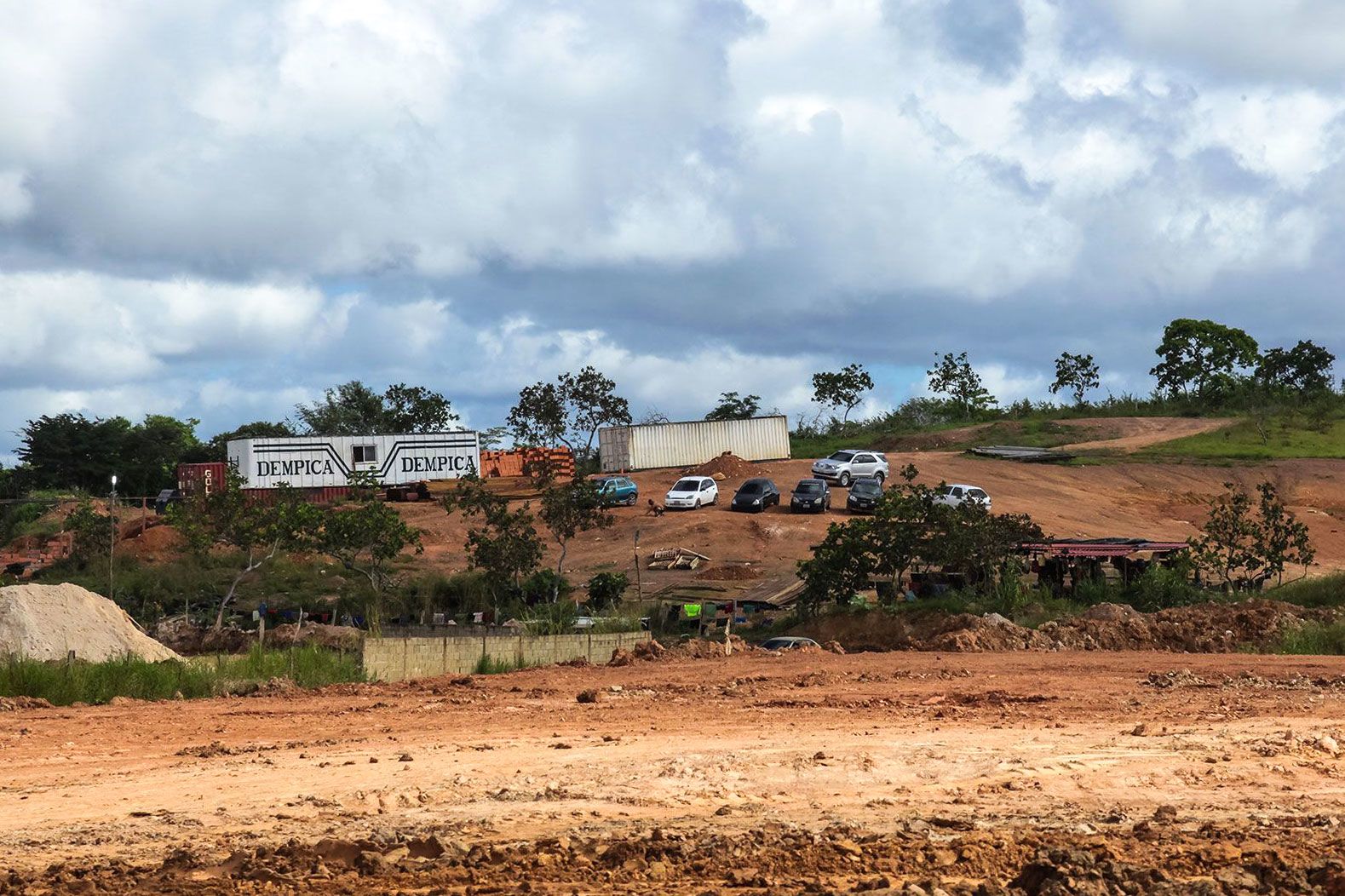
The creation of the Fondo Social Minero (Social Mining Fund) is established in Decree No. 2.165 with the Rank, Value and Force of Organic Law that Reserves to the State the Activities of Exploration and Exploitation of Gold and other Strategic Minerals, published in the Extraordinary Official Gazette No. 6.210 of December 30, 2015, but its constitution was completed in 2017. Two years later, Maduro celebrated with great fanfare the creation of another resource sink: the Fondo Rotatorio Minero, with a base of 16 million euros that would be managed by the Banco Bicentenario. Three years later, there are no reports or accounts regarding the administration of the capital.
There are also no open data or official references on the revenues generated by the operation of strategic alliances. In April 2018, the then Minister of Eco-Mining Development, Víctor Cano, affirmed that the 29 agreements signed by his office under the figure of "strategic alliances" would allow an investment of 180 million euros and profits to the country of about 775 million euros per year.
The collapse of services in mining municipalities has motivated boroughs such as El Callao to design a zoning ordinance, a tax and a Local Urban Development Plan that obliges mining companies to pay for the use of the municipality's land at a rate of 25 petros per month, equivalent to $1,500; and a tax rate of $50 per month per operation to the more than a thousand mills in the municipality.
Although the installation of plants did not stop during the pandemic, artisanal mining activity did suffer changes in El Callao, as there are fewer spaces for extraction by small miners. "There are no longer areas where the ordinary miner can work, they are handing it over to the big companies: Mina Isidora, Planta Perú, La Increíble," Mayor Lugo said.
The latter, La Increíble, has been developed since 1950 by small mining, but in recent years "they have given it to alliances, the miners left and today there are big companies working there." Although artisanal miners could enter these plants as labor, consulted sources explain that the small miner got used to going to the river or a “bulla” (miners slang for a new vein to extract gold) and not to work in a plant by shifts.
In front of the church of Plaza Bolívar, where the mass of the “madamas” is celebrated in the historic carnival of El Callao, artisanal miners with wooden bateas (similar to pans) say that they have chosen to go to work in La Ramona, a collectively owned mining sector three hours' walk from the town center.

Artisanal miners in the Plaza Bolívar in El Callao
Artisanal miners in the Plaza Bolívar in El Callao
Meanwhile, the activity of the open pit mines and vertical tunnels, where small miners work, has not stopped in the Sifontes municipality, where the deposits are mainly controlled by armed groups. This was confirmed during a visit to Las Claritas mines, 20 kilometers from the border with Guyana, in the same territory where Las Cristinas was located under the concession of the Canadian Crystallex, listed as one of the world’s largest undeveloped gold deposits, with reserves estimated at 1.5 million ounces, that is, about 468.7 tons of gold, equivalent to $27.5 billion.
There, the misty image of mining precariousness is exposed: a group of barefoot men manipulate a long hose submerged in a dense brown lagoon, among muddy streets and a few meters from grocery stores, improvised hairdressers, motorcycle workshops and hovels made of fiberboard and zinc roofs where they live with their children and pets. Families whose everyday life fits in a mine.
But these moving images could be misleading. In 2022 there are signs of a slowdown in mining: commercial activity in the villages has decreased, agree Ceferino Chacín, president of the El Callao Chamber of Commerce, and Erick Leiva, vice president of the Tumeremo Mining Chamber, where one of the largest massacres occurred in the region in 2016, the year of the creation of the Arco Minero del Orinoco.
During the tour of the mining towns, little noise was observed in the commercial zone of towns such as Las Claritas and Kilómetro 88 compared to previous years. Similar situation in towns such as Tumeremo and Guasipati. "In the streets you can quickly notice when there is less production in the mines," says the leader of the Mining Chamber of the capital of Sifontes.
“You can notice that there is reduced traffic on the streets and less noise from motorcycles. The wealth from the mines is not staying in these towns,” says Chacín. Some residents consulted replicate what the artisanal miners of El Palmar, Padre Pedro Chien municipality, warn: "all the companies are bankrupt."
Runrunes and Correo del Caroní requested information from the Ministry of Eco-Mining Development based in Caracas on the operation and productivity of these companies as well as from Carlos Osorio, president of the CVM in the Arco Minero del Orinoco, but no response was received until the closing time.




